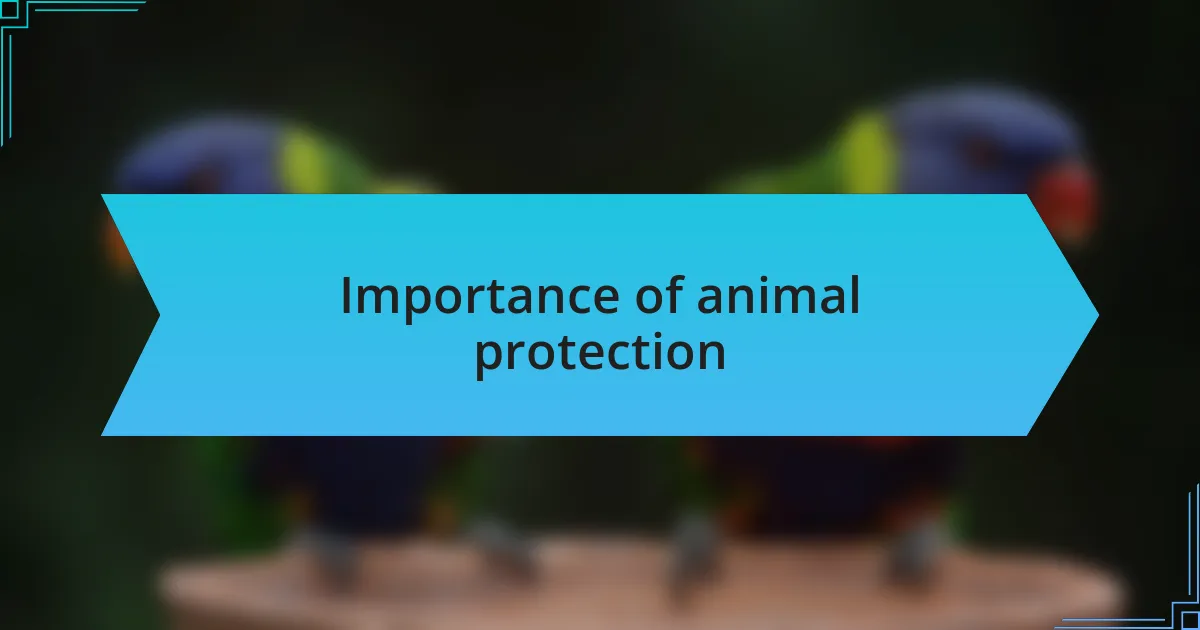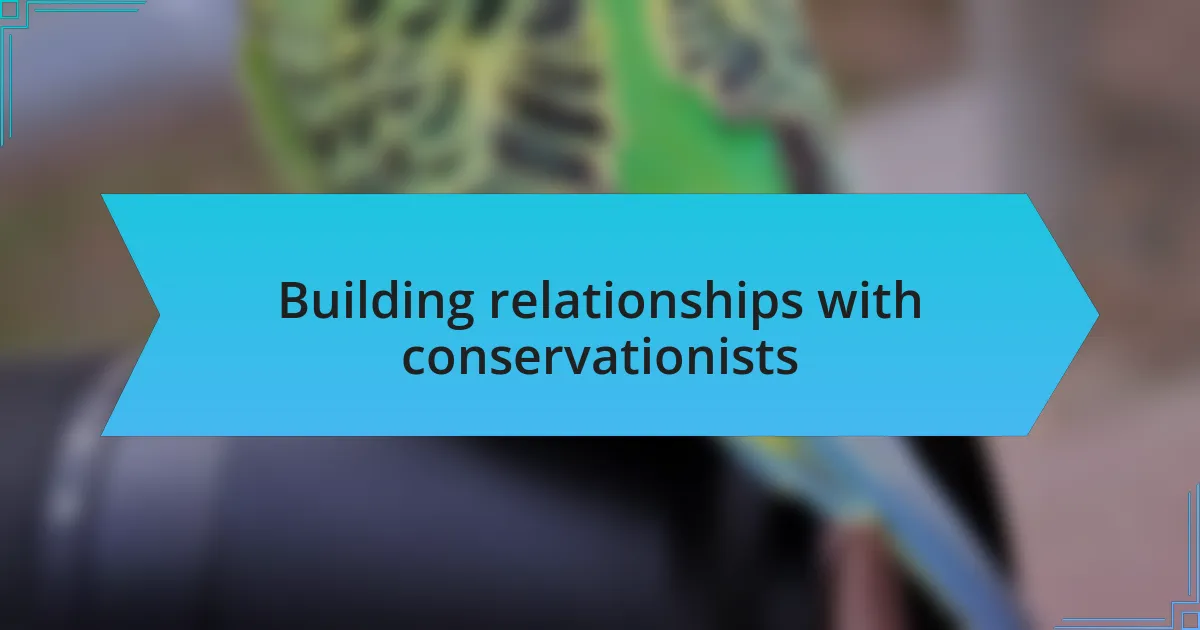Key takeaways:
- Local conservationists connect emotionally with their communities, often sharing personal stories that inspire collective responsibility for wildlife preservation.
- Animal protection is vital for sustaining ecosystems and enhancing biodiversity, emphasizing the interconnectedness of species and their roles in nature.
- Engaging with conservation groups through events and networking can foster meaningful relationships and community involvement in conservation efforts.
- Volunteering and shared experiences with conservationists provide mentorship opportunities, inspiring individuals to advocate for environmental protection.

Understanding local conservationists
When I first started connecting with local conservationists, I quickly realized that their passion often stems from deep emotional ties to the land and its inhabitants. I remember a conversation with a conservationist who tearfully shared how a childhood experience with a wounded animal sparked their lifelong commitment to preserving wildlife. It made me wonder: how many of us have had those poignant moments that shape our path forward?
Local conservationists often operate at the intersection of science and community, blending empirical knowledge with heartfelt storytelling. I was struck by how they engaged with everyday people, explaining complex ecological concepts in ways that felt relatable and accessible. Have you ever seen someone illuminate a room simply by sharing their love for nature? That’s what these conservationists do; they ignite a collective sense of responsibility and hope.
Their efforts are not just about protecting species; they aim to foster a deeper understanding of how interconnected we all are. I recall attending a workshop where we discussed the ripple effects of local biodiversity. The insights I gained that day were invaluable—making me reflect on the impact of even small actions within our community. Isn’t it fascinating how one person’s dedication can ripple outward, inspiring entire communities to change?

Importance of animal protection
Animal protection is crucial not just for wildlife, but for the health of our ecosystems and, ultimately, ourselves. I remember visiting a sanctuary where I met a rescued bird. Its broken wing was a stark reminder of the consequences of neglect. Seeing that bird’s struggle made me realize how our actions directly affect the lives of countless creatures, emphasizing the necessity of advocating for their protection.
Moreover, protecting animals promotes biodiversity, which is essential for sustaining the balance of nature. I encountered a local biologist who shared how the decline of a single species can lead to a cascade of changes in the ecosystem, affecting everything from plant growth to food availability for other animals. It left me pondering: how often do we consider the intricate web of life surrounding us? Each species plays a role, and when we safeguard them, we’re also preserving our own future.
The emotional connection we have with animals can serve as a powerful motivator for action. During a community event, I watched as children painted portraits of their favorite animals, visibly excited about their creations. Their joy was infectious, and it reminded me that fostering love for wildlife opens the door to understanding why we must protect them. Isn’t it amazing how a simple act of creativity can cultivate future conservationists?

Ways to find conservation groups
Finding local conservation groups can be a fulfilling journey. One of the most effective ways I’ve discovered is through community boards and social media. I remember stumbling upon a flyer at my local coffee shop about a nearby beach cleanup hosted by a conservation organization. It turned out to be a fantastic way to meet like-minded individuals and became the first step in my own conservation journey.
Another approach is to attend workshops and seminars focused on environmental issues. When I participated in a local sustainability workshop, I was amazed by the connections I made. The speakers were not only knowledgeable but also eager to share information about local groups that I could join. It made me wonder, how many resources are readily available if we take the time to engage in community events?
Don’t underestimate the power of networking through friends and family either. I recall having a conversation with a friend about my passion for wildlife protection. It turned out she was connected with a grassroots organization devoted to preserving local habitats. This unexpected link opened doors to volunteering opportunities I hadn’t known existed before. Isn’t it interesting how sharing our passions can lead to discovering support systems we never knew we needed?

Building relationships with conservationists
Building relationships with conservationists often starts with genuine conversations. I remember joining a local wildlife discussion group where I felt an immediate sense of community. Sharing my passion for animal protection sparked discussions that went deep into conservation strategies and challenges, creating bonds that are still important to me today.
Volunteering for local projects can be a transformative experience. During a habitat restoration event, I connected with several dedicated conservationists who became mentors in my journey. Their passion was infectious, and I found myself not just working alongside them but learning from their hands-on experiences. Isn’t it amazing how shared endeavors foster stronger connections?
Moreover, providing support to a cause can lead to unexpected friendships. I once wrote to a conservation organization, expressing my admiration for their work. To my surprise, they invited me to a series of events, where I met others who were equally passionate. Through these encounters, I realized that every small action contributes to building a network that is not just about conservation, but about creating a community invested in making a difference.

Sharing ideas with local groups
Sharing ideas with local groups can lead to unexpected discoveries. I remember attending a community forum where everyone was encouraged to voice their opinions on local wildlife issues. The exchange of perspectives was not only enlightening but also reinforced the importance of collaboration; it was like a light bulb moment to see how diverse insights could lead to innovative conservation solutions. Have you ever felt that rush when your thoughts align with others, sparking a drive to tackle a shared goal?
In another instance, I participated in a brainstorming session for an upcoming conservation event. At first, I was timid, unsure of how my ideas would be received. However, when I finally shared my concept for an educational workshop, it was met with enthusiasm. The validation I felt not only boosted my confidence but strengthened my connection with the group. Isn’t it incredible how such moments can transform individuals into advocates for a cause?
Sometimes, the most valuable discussions happen in informal settings. While sipping coffee with fellow conservationists, we casually exchanged stories about wildlife encounters that sparked our passion. These moments of vulnerability and authenticity foster a deeper understanding of one another’s dedication to animal protection. It made me realize that sharing ideas isn’t just about discussing strategies; it’s about building relationships grounded in shared experiences and values.

Participating in conservation events
Participating in conservation events has a way of deepening connections within the community. I remember attending a local beach cleanup where I met like-minded individuals passionate about marine life. The collective effort was not only impactful in removing debris but also sparked friendships. Isn’t it fascinating how shared purpose can knit people together in such a meaningful way?
One particular event stands out in my memory—an educational workshop focused on wildlife preservation. As I helped set up the space, I felt a wave of excitement wash over me when I saw families arriving, eager to learn. Interacting with attendees and hearing their stories was incredibly rewarding. It made me ponder: how can small events like these inspire lasting change in our daily lives?
I’ve also found that participating in conservation events often leads to unexpected opportunities for collaboration. During a fundraising gala, I connected with several eco-entrepreneurs who shared their innovative approaches to sustainability. Hearing their motivation and struggles made me reflect on my contributions to conservation. It left me wondering: what can we achieve together if we combine our resources and ideas?

My personal journey with conservationists
Meeting conservationists in my journey has felt like unlocking a door to a vibrant world. At a local wildlife rescue center, I volunteered for a day and was instantly captivated by the dedication of the staff. Their passion for rehabilitating injured animals made me think: what drives someone to commit their life to such important work? It’s a question I still ponder every time I see a rescued creature thrive.
One of the most memorable encounters I had was during a nature walk led by an experienced conservationist. They shared stories of local ecosystems and the delicate balance of each species. As I listened, I could feel the weight of their knowledge and the urgency of their message about protecting our environment. It sparked something inside me—could I also be a voice for these silent defenders of biodiversity?
Through these experiences, I began to view conservationists not just as colleagues, but as mentors. I remember one late evening, after a community meeting, where a seasoned conservationist pulled me aside and offered to guide my first steps into advocacy work. Their encouragement touched me deeply and made me realize that mentorship is a powerful tool for igniting change. Isn’t it incredible how one conversation can alter the course of your journey?